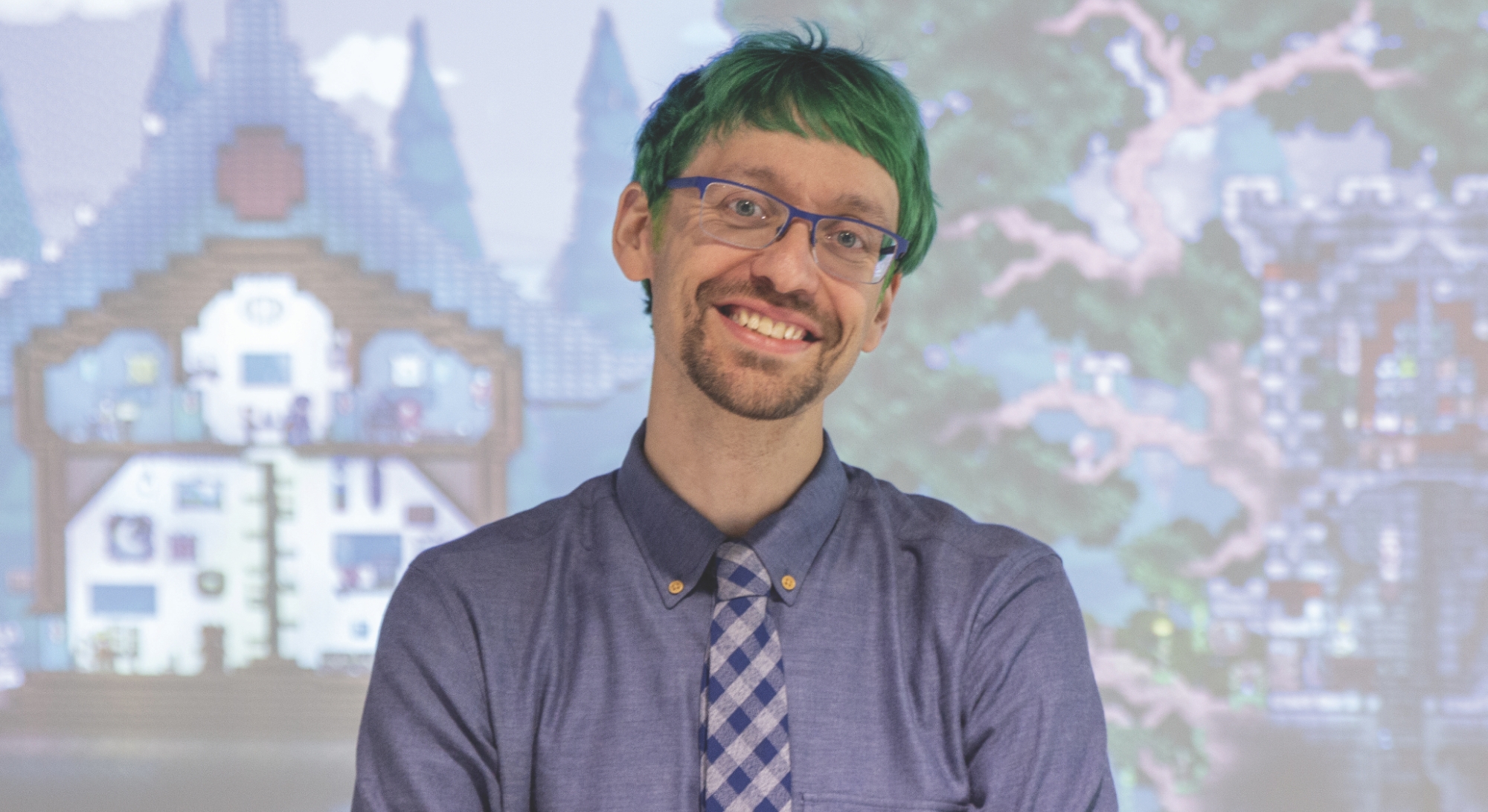
Game designer and theorist Patrick Jagoda delivered the 2024 Aims of Education address in Rockefeller Chapel. (Photo courtesy Patrick Jagoda)
An excerpt from the 2024 Aims of Education address.
In his 1978 book The Grasshopper [University of Toronto Press], philosopher Bernard Suits retells Aesop’s fable “The Ants and the Grasshopper.” A starving Grasshopper, fiddle under its arm, happens upon a colony of Ants. The Grasshopper asks for something to eat. The Ants are shocked and ask why it hasn’t been preparing for winter. The Grasshopper replies it was busy making music. The Ants are disgusted. They turn their backs on the Grasshopper and leave it to die. The moral: “There’s a time for work and a time for play.” A fairly harsh lesson, decidedly pro-Ant in its orientation.
Bernard Suits’s version of the fable is radical. His retelling begins the moment after the Ants refuse. The Grasshopper speaks to its disciples. One offers to share food. The Grasshopper refuses. The disciple objects: “Most of us realize that our labor is valuable because it permits us to play, and we are presumably seeking to achieve some kind of balance between work input and play output.” In other words, the disciple gives us a version of the common work-life balance line. This is a reasonable point, but the Grasshopper isn’t interested in reason. It holds onto the principle of a life devoted entirely to play.
In its dying breaths, the Grasshopper tells its disciples, “I have always had a recurring dream … that everyone alive is in fact engaged in playing elaborate games, while at the same time believing themselves to be going about their ordinary affairs. Carpenters, believing themselves to be merely pursuing their trade, are really playing a game, and similarly with politicians, philosophers, lovers, murderers, thieves, and saints. Whatever occupation or activity you can think of, it is in reality a game.”
Is life a game? You can take this question either as literal or figurative, structural or provocative. There is no wrong answer, though any answer has enormous consequences.
It’s worth contemplating what is lost if we liken life to a game—especially a competitive, winner-takes-all contest. Of course, competitive games are only one genre. There are games of chance, cooperative games, puzzle games and riddles, theater games, as well as world-making games of make-believe.
So what does this have to do with the aims of education?

My own education took a circuitous route. I started as a philosophy and literature double major. I went on to earn a PhD in English, moved to a postdoc in media studies, and now I’m a professor who designs games with medical professionals, climate scientists, and theater makers. To return to Aesop, I could have joined the Ants in gathering my resources for the winter. Instead, I foolishly decided to take the Grasshopper as my model.
Games are a space of safe failure. They are one of the few places in American life, in an often-unforgiving economy, in which people are allowed—even encouraged—to fail, fail often, and keep going. Drawing from my own experience as a game designer, game studies scholar, and educator, I want to invite you to fail.
I hope you will fail in profound ways that help you imagine new, efficacious, and just ideas. Failure is a privilege that not everyone has. By being admitted to the University of Chicago, you have earned the right to fail in this way. To reach that objective, you will have to take some risks.
Sometimes people ask me what my favorite game is. Depending on my mood, I throw out Earthbound or Stardew Valley, Breath of the Wild or Outer Wilds. The better question might be: What would my ideal game look like?
My ideal game would be long—not a five-minute round of Wordle. It might last, say, four years. (Wow, that’s a long game.) Let’s say it’s a persistent open world game, where you start in a central quad and can explore a reasonably sized map. This game would certainly feature skill trees. Those skill trees might include the ability to read closely, analyze culture, historicize race, or think through knotty ethics problems.
A player might boost their XP in domains like algebraic geometry, probability, topology, or logic. They might practice hypothesis testing, so they can run experiments on the open world and backwards engineer exactly how its physics or chemistry engines work. The best players might develop a few crafting abilities: write a short story, produce a film, even design a video game.
Since this is my ideal game, it would be massively multiplayer and cooperative. As the original 1986 Legend of Zelda game taught me, “It’s dangerous to go alone!”
My design would have an endgame and a final boss. But this would be harder than a Bowser in Mario, a Ganon in Zelda, or a Dr. Robotnik in the Sonic games. The players of my game would decide what their boss was. Even this final moment would be one of collaborative co-creation, because my players would secretly be codesigners.
As you might have surmised, you’re about to play a version of my ideal game.
Patrick Jagoda is William Rainey Harper Professor in the Departments of Cinema and Media Studies, English Language and Literature, and Obstetrics and Gynecology, and the College.
